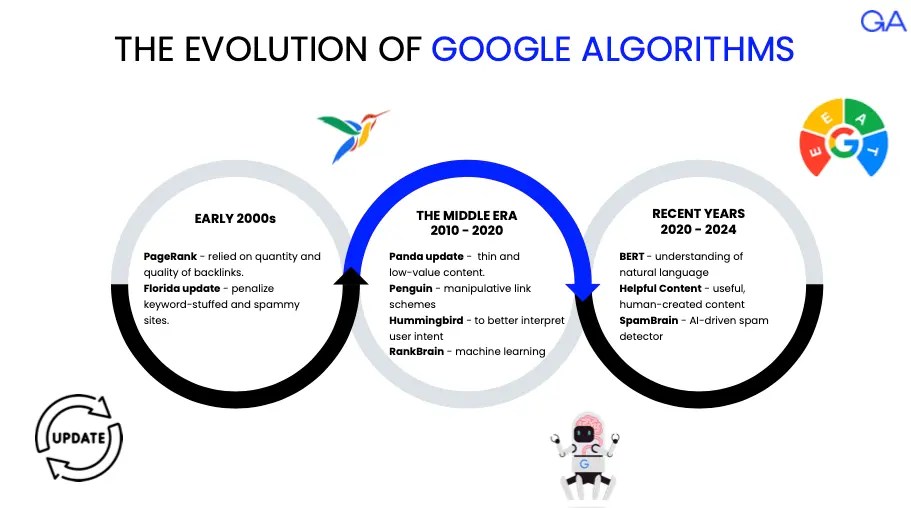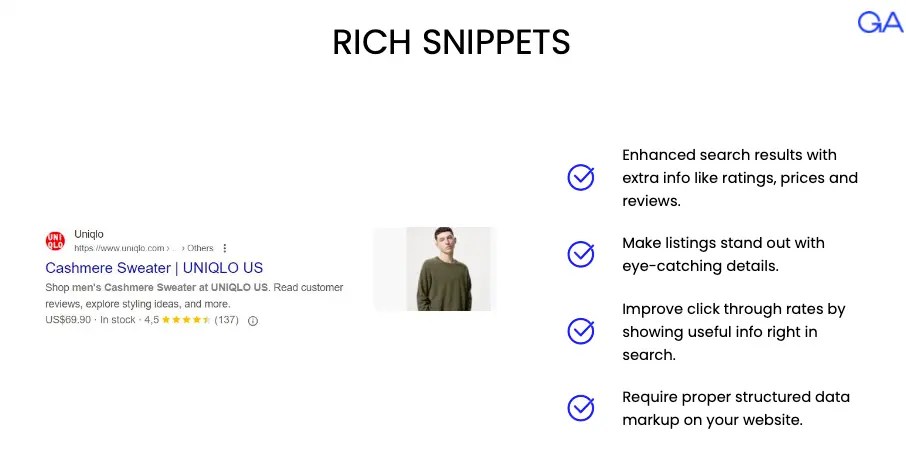
Key takeaways from the Lesson by Oliwia Urban, Senior SEO Specialist at GA Agency.
7+ years of experience in international SEO strategy, on-page optimization, and content development. Known for delivering actionable, measurable results for fashion and lifestyle brands across markets such as the UK, US, Poland, and the Middle East. Leads a team of SEO professionals with a people-first, strategy-driven approach.
Evolving SEO with Google Algorithm Updates
Google’s algorithms have come a long way—from early PageRank and the 2003 Florida update aimed at reducing spam, through Panda, Penguin, Hummingbird, and RankBrain, to the recent AI-powered Helpful Content Update and SpamBrain. The focus has consistently shifted toward rewarding quality, relevance, and trust. In 2025, Google’s core updates and ongoing refinements emphasize high-quality, user-centric content paired with deeper AI understanding of user intent.

Adapting to the Age of “MSEO” and Zero-Click Trends
Today’s SEO isn’t just about Google—it’s about reaching audiences across multiple platforms (“MSEO”): Google, Bing, LinkedIn, AI-powered engines (e.g., ChatGPT, Perplexity), and more. Search Engine Results Pages (SERPs) have evolved to include AI overviews, rich snippets, shopping panels, “People Also Ask,” video and image carousels—often resulting in zero-click scenarios. To thrive, we optimize for these features: using schema markup, concise Q&A content, FAQs, bullet-point formatting, and localized SEO. This allows us to “answer in place” and capture valuable visibility directly in the SERP.
Here you are some of the key points about SERP evolution and AI impact:
Google’s Search Engine Results Pages (SERPs) are undergoing a significant transformation. Gone are the days of a simple layout with sponsored ads at the top and classic “blue links” below; today’s SERPs are rich with AI-driven features like AI Overviews, featured snippets, People Also Ask panels, image and video carousels, and shopping grids. These elements occupy more screen space and answer user queries directly—often without the user clicking through to a website. The goal of these changes is to enhance user experience: faster, easier answers tailored to intent, seasonality, and personal search history

This shift has profound implications for SEO. With zero-click searches—where users don’t leave the SERP—increasing dramatically (up to 80% when AI Overviews are present), traditional click-through metrics are declining. To adapt, brands must optimize content for SERP features: structuring Q&A and FAQ sections, implementing schema markup, writing concise answers, and targeting keywords that trigger AI-driven elements. Visibility in AI Overviews and featured snippets—not just rankings—matters more than ever, as they build brand authority and influence even without clicks.
Google Shopping is evolving beyond bids to value-based ranking.
With AI-infused shopping results, Google now evaluates product relevance and feed quality—alongside traditional bidding—to determine visibility. Well-structured, information-rich product feeds (complete with attributes like size, material, GTIN, pricing, and availability) are increasingly decisive. As a result, even without high bids, merchants with optimized feeds can outperform competitors simply by offering deeper, more accurate product data.
In-house vs. agency-managed shopping feed optimization? Partnering with an agency like ours offers immediate access to specialists who understand the latest tools, AI-driven feed generators, schema/structured-data implementation, and performance monitoring best practices. While in-house efforts require hiring and training multiple experts, agencies streamline processes and provide consistent optimization. For clients with extensive catalogues, this approach reduces workload—no need to juggle Google Merchant Center setup, AI-assisted structured data tools, or frequent feed audits—and avoids relying solely on ad spend to capture traffic and conversions.

Google Shopping is now driven by AI-powered ranking that values relevance and feed quality—not just bids—so merchants with well-structured, comprehensive product feeds (complete with accurate titles, images, pricing, stock, and review data) can outperform competitors regardless of budget. Partnering with an agency ensures your feeds are continuously optimized: specialists handle feed audits, structured-data implementation, attribution of reviews, and AI-driven feed improvements, while freeing you from managing Merchant Center complexities. This approach minimizes manual workload and maximizes performance—making ad spend more effective and improving visibility across Google Shopping and AI-driven shopping surfaces.

Link building for SEO
Link building remains a crucial aspect of SEO, but the emphasis has shifted firmly from quantity to quality. Search engines now prioritize backlinks from authoritative, relevant, and trustworthy sources, which means fashion brands should focus on building genuine relationships and earning links through valuable, niche-specific content. Effective strategies include personalized outreach tailored to a recipient’s audience, using AI to identify relevant linking opportunities at scale, and securing mentions through expert contributions or PR efforts. A strong, trusted backlink profile ultimately enhances domain authority and supports long-term SEO visibility and growth.
To summarize, SEO in 2025 requires a multidisciplinary approach: strong technical foundations, rich semantic content, and optimization for the AI-driven world. It’s no longer just about ranking—it’s about being the trusted source that AI systems cite and serving user intent in real time.
The key takeaways:
🚀 1. AI-Driven Optimization based on AI-SEO, AEO & GEO:
– AEO (Answer Engine Optimization) focuses on structuring content—Q&A, structured data, concise conversational tone—to appear in AI responses like Google’s SGE, ChatGPT, or Perplexity
– GEO (Generative Engine Optimization) ensures your content gets cited or integrated in generative AI outputs, using metadata, llms.txt, and topical authority
A combined hybrid strategy—SEO + AEO + GEO—is essential to maintain visibility across both traditional search and AI‐powered platforms
🧠 2. AI-Enhanced Content Tools & Human Oversight
Tools like Surfer SEO, Clearscope, MarketMuse, and Alli AI enhance relevance and semantics—but human creativity must polish them to avoid generic, machine-like output
Efficiency is key: AI helps with metadata, ideation, summarization, and coding, but content needs authentic voices to stand out.
🎯 3. E-E-A-T & Originality
Google’s Experience-Expertise-Authority-Trustworthiness guidelines remain crucial. Featuring real authors, bios, and original research or data improves credibility
An “OriginalContentScore” rewards unique, experience-based insights over recycled content
⚡ 4. Core Web Vitals & UX
Technical metrics—LCP, FID, CLS—are now fundamentals for both SEO and AI indexing. Fast, stable pages enhance user engagement and bots’ crawling efficiency
🎙️ 5. Voice & Conversational Search
As voice assistants grow, use natural speech patterns and long-tail conversational keywords. Structuring content in FAQ or Q&A formats can capture voice search results
📹 6. Visual & Video SEO
Images and videos are critical: include rich metadata, alt-text, transcripts, and schema markup to surface in image/video carousels and AI answers
💬 7. Semantic Search & User Intent
SEO is shifting from keyword focus to intent: build topic clusters that cover related queries and contextually align with user needs
🌍 8. Zero-Click Answers & SERP Real Estate
With AI providing direct answers, optimize for featured snippets, People Also Ask, and knowledge panels. Even without clicks, you gain visibility
📍 9. Local & Mobile-First Optimization
Local businesses should leverage Google Business Profiles, hyper-local content, and voice search. Mobile-first design is essential as Google prioritizes mobile indexing
🛠️ 10. Emerging Tools & Metrics
New platforms (AI EngineBoost, Alli AI, RankIQ) support hybrid SEO, AEO, and GEO strategies
SEO metrics are evolving: monitor AI‐driven visibility (appearances in AI responses) not just rankings and CTR.
✅ 2025 SEO Checklist: discover the 5 key priorities:
1. Hybrid Optimization Combine SEO, AEO, GEO strategies
2. UX & Performance Core Web Vitals, mobile-first design
3. Authority Boost E-E-A-T with real authorship & data
4. AI Formatting FAQs, structured data, conversational tone
5. Visibility Metrics Track AI mentions and zero-click placements

About GA – Your Truly Omnichannel Digital Agency
GA is an omnichannel digital agency specializing in international markets. With local experts across 25+ countries speaking 18 languages, we ensure a truly local approach to SEO and paid media. This means strategies are tailored to each client’s specific market—aligned with local audience behaviours and cultural nuances—giving us a unique edge in delivering relevant, impactful campaigns.
At GA London headquarters, a team of 60+ specialists offer two core pillars of service: SEO and Paid Media. But their capabilities extend further, covering strategy planning, tools management, analytics, content writing, digital PR, CMS management, and comprehensive audits. We collaborate closely with clients to define and agree on tailored solutions upfront—solutions that drive measurable results and align with their business goals.